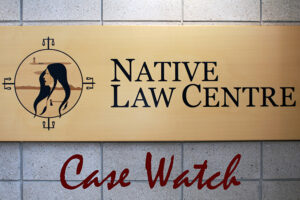Appeal dismissed. The hereditary chiefs of the Gitanyow people are actively pursuing an Aboriginal title and rights claim that includes an area that overlaps with the Nisga’a Final Agreement. The concerns regard the decision of the Minister on the basis of a breach of the duty to consult. The lower court decision added an extra step to the Haida test in cases where there is an overlap between established treaty rights and ones yet unproven. The Court of Appeal rejects the need for any modification of the Haida test.
The Appellants are hereditary chiefs of the Gitanyow people [collectively as “Gitanyow”]. The Gitanyow have an outstanding claim for s. 35 Aboriginal rights in an area described as the Gitanyow Lax’yip.
The Nisga’a Treaty sets out the s. 35 rights of the Nisga’a. It provides that nothing in the Treaty affects any s. 35 rights for any Aboriginal people other than the Nisga’a Nation. The Nisga’a Treaty established a hunting area known as the Nass Wildlife Area where the Nisga’a have non-exclusive rights to hunt. The Minister of Forests, Lands and Natural Resource Operations [“Minister”], has certain decision-making responsibilities in relation to determining the total allowable harvest in the Nass Wildlife Area and the annual management plan which regulates Nisga’a citizens’ hunting. The nature and scope of the decision-making responsibilities are set out within the Nisga’a Treaty.
The Gitanyow Lax’yip overlaps with the Nass Wildlife Area. As a result, decisions made concerning the Nass Wildlife Area may have the potential for affecting activities within the Gitanyow Lax’yip. In order to protect the rights of Indigenous groups such as the Gitanyow pending claims resolution, the Crown has a duty to consult and, where appropriate, accommodate in circumstances where the Crown has knowledge of the potential existence of an Aboriginal right and contemplates conduct that might adversely affect it. This is known as the Haida test (Haida Nation v British Columbia (Minister of Forests), [2005] 1 CNLR 72).
This appeal concerns two decisions of the Minister made in 2016 approving the total allowable harvest of moose and the annual management plan for the 2016-2017 hunting season in the Nass Wildlife Area. Prior to making these decisions, the Minister had consulted with the Gitanyow concerning the total allowable harvest, but not concerning the annual management plan.
On judicial review, the chambers judge held that the duty to consult was not triggered by the approval of the annual management plan, and that the consultation in relation to the total allowable harvest was adequate. In reviewing these issues, the chambers judge concluded that the Haida test to determine the existence of a duty to consult was not adequate to deal with the circumstance where a conflicting treaty right was at issue. She concluded that the Haida test required modification to preclude a duty to consult an Indigenous group claiming s. 35 rights when the recognition of such a duty would be inconsistent with the Crown’s duties and responsibilities to the Indigenous peoples with whom it has a treaty. It is unnecessary, however, to modify the Haida test in order to recognize the limits of accommodation that treaty rights impose. The Haida test that has been applied consistently over the past 15 years has sufficient flexibility within it to encompass these issues.
Despite the conclusion that the modification of the Haida test was unnecessary, the Court does not consider that the reviewing judge erred in her fundamental approach to the issue before her. The analysis of the chambers judge properly focused on the three-part Haida test, and in particular the third element, which asks whether the proposed Crown conduct has the potential for affecting the claimed right. This is primarily a question of fact, to be reviewed on a deferential basis. Applying the Haida test, the Minister did not err in concluding that the duty to consult was not triggered in relation to the annual management plan. The consultation undertaken by the Minister in relation to the total allowable harvest was adequate in the circumstances.



